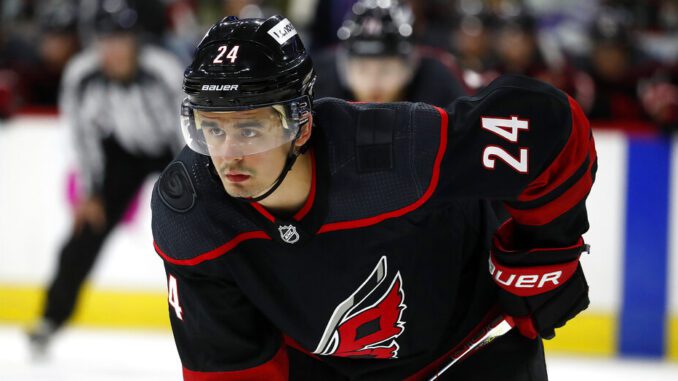
The Hurricanes were the darlings of the postseason after trading for Brent Burns and Max Pacioretty. Carolina got a larger-than-life replacement for Tony DeAngelo in Burns, a 6-foot-5 blue line behemoth with a beard nearly as long.
Pacioretty, meanwhile, gives the Hurricanes a prolific sniper who ranks 20th among active players with 323 goals over 14 NHL seasons with Montreal and Vegas.
The latter was acquired from the Golden Knights along with defenseman Dylan Coghlan for future considerations — code for “nothing, but maybe do me a favor down the road” — and softened the blow of Carolina losing Vincent Trocheck, Nino Niederreiter and the combined 45 goals the duo took with them to New York and Nashville, respectively.
That softened blow felt more like an uppercut when the Hurricanes announced last week that the 33-year-old Pacioretty would undergo surgery on a torn Achilles tendon.
What seemed like a luxury addition instead now looks like a gaping hole, an arrow through Carolina’s plans to emerge from a disappointing postseason as an even stronger Stanley Cup contender in 2022-23.
Instead of Pacioretty roaming the left wing of a line with Sebastian Aho, Jesperi Kotkaniemi or Jordan Staal, the Hurricanes’ biggest front-line addition will be watching from the press box until his recovery is complete.
The knee-jerk reaction on social media was that Carolina needed to replace Pacioretty immediately, with names like Vladimir Tarasenko and Nazem Kadri rising to the top of the wish list.
St. Louis’ Tarasenko (one year left with a $7.5 million cap hit) and Kadri (a free agent rumored to have a $7 million annual salary offer from the Islanders) could make mathematical sense if Pacioretty was lost for the season. But with Pacioretty’s $7 million cap hit due back on the books before the spring, neither are a logical fit.
Which brings us to Pacioretty’s recovery time. The Hurricanes, in their press release announcing Pacioretty’s injury, said his “expected recovery time is six months.” That would bring the former Michigan Wolverines standout back into the fold in February.
That didn’t stop many from suggesting Carolina should stash Pacioretty on long-term injured reserve until the end of the regular season — two months after he should be healthy — and use the $7 million in savings to add a player, and then bring Pacioretty back for the playoffs when the salary cap in no longer calculated.
But that’s not happening, at least not to start the season. If Pacioretty were to suffer a setback in his recovery, LTIR could be an option for the Hurricanes. But with his return slated for February, Carolina will likely put Pacioretty on injured reserve and roll with what they have.
So where will the lost goals come from without Pacioretty?
For one, Carolina believes Kotkaniemi can be a serviceable replacement for Trocheck. The 22-year-old logged just over 12 minutes a night last season and should see about a 50% boost in ice time. If his production equals his increased ice time, Kotkaniemi should finish in the 40- to 50-point range — on par with the 51 points Trocheck had last season.
Niederreiter’s 24 goals — including 20 at even strength — also need to be replaced. The good news is the team can certainly expect more from Seth Jarvis, who had 17 goals as a rookie.
The odds are Jarvis will be even better in 2022-23 due to a combination of experience and, like Kotkaniemi, more ice time. Since the 2010-11 season, only two rookies have played fewer minutes and put up more points than Jarvis’ 40 points in 943:30 minutes last season — Connor McDavid (48 points in 849:42 minutes in 2015-16) and Jason Robertson (45 points in 861:13 minutes in 2020-21). McDavid followed his rookie season with 100 points, and Robertson exploded for 41 goals and 79 points last year.
Jarvis averaged under 14 minutes per game last season but should also move into the 17- to 18-minute range this year. It would be fair to expect 15 or so more points this season from Jarvis without even considering that he could have a breakout campaign like his two peers.
The team’s two wild cards are Martin Necas and Ondrej Kase.
Necas is coming off a disappointing third NHL season in which he put up nearly identical numbers to the previous year but in 25 more games played. Necas has the talent to be at least a 20-goal and 50-point player, and he should be given every opportunity to do that in Pacioretty’s absence.
Kase has the ability to play at that pace, but the question has been if he can stay healthy enough to put up those numbers over 82 games. The 26-year-old Kase has played more than 55 games in a season just once in his six-year career, and his lone 20-goal season was when he played a career-high 66 games in 2017-18.
On the surface it seems like a lot needs to go right for the Hurricanes to replace Trocheck and Niederreiter’s output, and Pacioretty’s injury certainly makes that harder. But while the Hurricanes’ “need for goal scoring” has been echoing through Twitter since the team was knocked out of the postseason, the truth is Carolina was fourth in goals in Eastern Conference last season — more than the Capitals, Penguins, Bruins and Rangers.
And come February, they should be getting back a 30-goal scorer.
Everyone take a deep breath: The Carolina Hurricanes are going to be just fine.



